Perfect bite
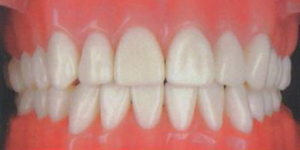
A bite is a feature of the closure of the upper and lower dentitions in the static position of the lower jaw.
Bite is right and wrong.
With a correct bite, the front teeth of the upper row overlap the lower incisors by about a third of their crown part, the upper lateral teeth slightly cover the lower and there are no gaps between the teeth in the row.
There is also the concept of "occlusion", which dentists use to indicate the type of closure of the teeth during movement of the jaws while chewing.
The correct bite can also be called physiological, and the wrong bite can be called abnormal.
Unfortunately, the ideal bite is very rare.
Why it's important to have the right bite
The presence of an ideal bite in a person is important, both from the point of view of aesthetics and physiology.
- A person who does not have even teeth, tries not only to hide a smile from others, but also once again communicate with someone.
- In connection with this complex, such people are more often harassed by communication with the opposite sex, friends and at work.
But the most important are physiological problems:
- First of all, the quality of chewing food depends on the occlusion of the teeth.
- If the closing of the teeth is broken, then a person cannot do it well.
- Defectively chewed food will not be able to digest well and be absorbed by the body. And this can lead to the occurrence of diseases of the gastrointestinal tract.
- In addition, with a malocclusion, the load on various parts of the jaw is not distributed evenly, which will contribute to faster wear of teeth subject to increased stress.
Signs of a perfect bite
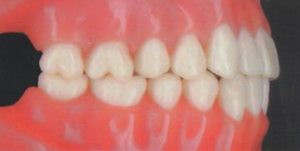
To determine the correct bite or not, it is necessary to stand in front of the mirror, and then swallowing, fixing the teeth in this position.
The line of closure of teeth can determine the presence of anomalies.
With a normal bite, the teeth closure line should have the following symptoms:
- The absence of gaps between the teeth of the upper and lower jaws.
- Upper canines and incisors should cover the lower ones by no more than one third of their crowns.
- The cutting edges of the lower incisors should be in contact with the palatine tubercles of the maxillary incisors.
- Imaginary vertical lines drawn between the upper and lower incisors should normally coincide.
- If the bite is correct, then with chewing movements of the jaws, the upper and lower premolars and molars should not lose contact with each other.
- The upper dental arch has the appearance of a semi-oval, and the lower one - parabolas.
- The size of the upper dental arch is larger, since the upper teeth should be inclined towards the vestibule of the mouth, and the lower arch should be slightly smaller and the teeth inclined towards the oral cavity.
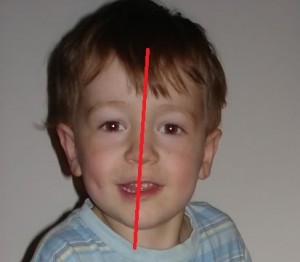
You should also pay attention to the following points:
- When assessing the type of closure of the teeth, it is also important to pay attention to the presence of symmetry of the face shape.Asymmetry indicates the presence of an anomaly.
- With a malocclusion, a speech defect such as lisping can often be observed.
- During chewing, a person may feel the presence of clicks in the temporomandibular joint.
- Complaints of frequent headaches.
Types of Proper Occlusion
The correct bite can have the following varieties:
- The standard is the orthognathic bite of the teeth. People with such a bite have the most beautiful smile, provided they have even teeth. A sign of this bite is that. That the upper incisors overlap the lower ones by no more than one third of the height of their crowns.
- A direct bite, the difference from the previous one is that the upper incisors are in contact with the cutting edges with the lower. The disadvantage of this occlusion is that with this position of the front teeth, they are subject to rapid abrasion, since when chewing food they have the main burden.
- Progenic bite, which many dentists attribute to anomalies. A sign of such a bite is the lower jaw slightly advanced. The teeth are tightly closed and the lower teeth do not protrude beyond the front teeth of the upper row.
- The biprognathic bite of the teeth is characterized by the fact that the teeth of the upper and lower row are inclined in the direction of the vestibule of the mouth.
- An opistognathic bite is a type of closing of the teeth when the upper and lower front teeth are inclined towards the oral cavity.
What type of bite is considered an abnormality
There are several levels of pathology:
- Change in the shape or position of the teeth or their number.
- An increase or decrease in the dentition.
- Changing the position and size of the jaw bones.
The severity of the development of the anomaly is influenced by parameters such as the area of deformation and the degree of curvature.
In the diagnosis of occlusion pathology, it is important not only to determine the anomaly, but also to establish the cause that caused the development of this defect.
Video: “Wrong bite. Classification of anomalies and bite "
Types of pathology
There are five main types of malocclusion:
- Distal (prognathic) bite. With such an anomaly, a strong development of the upper or underdevelopment of the lower jaw is observed.
- The medial (mesial) bite of the teeth is observed with a significant extension of the lower jaw bone forward and the upper teeth overlap with the lower ones. Another such anomaly is called lower prognathia or reverse bite.
- An open bite is a pathology characterized by a lack of closure of the teeth of both jaws. Non-closure can be observed in the area of the posterior teeth (lateral open bite) or the anterior group of teeth (anterior open bite).
- In the presence of a deep bite, the lower incisors are closed by the upper ones by more than half. This anomaly is also called "traumatic bite."
- In the case of a cross bite, an underdevelopment of one or two sides of the jaw, both upper and lower, is observed. In this case, the dentition, like scissors, intersect each other.
There is also a reducing occlusion that results from abrasion or loss of teeth.
Reasons for the development of pathology
An abnormal bite of teeth can be hereditary or acquired. Hereditary causes are transmitted genetically, for example, the size of the jaw bones.
The development of malocclusion, as a rule, begins from early childhood due to various factors affecting the jaw bones and staging:
- With prolonged use of the nipple or dummy, as well as the presence of such a bad habit in a child as sucking fingers or toys, a vertical disocclusion or an open front bite develops.
- In the presence of chronic diseases, ENT organs, which are accompanied by respiratory failure, anomaly of the bite can also form.
In children and adults, a dentofacial anomaly can form under the following conditions:
- Amid trauma to the jaw or teeth.
- Violation of tooth changes.
- Untimely or incorrect dental prosthetics.
- A prolonged absence of teeth leads to changes in the jaw bones.
- The presence of constant stress leads to an increase in the tone of the masticatory muscles, increased abrasion of the teeth, bruxism, which as a result of a high load on the chewing apparatus provokes a displacement of the jaw bones.
Photo: before and after
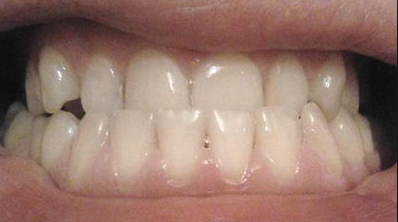 |
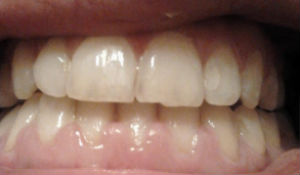 |
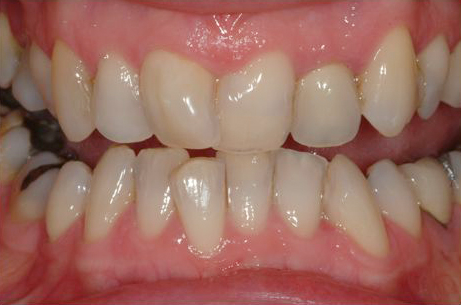 |
 |
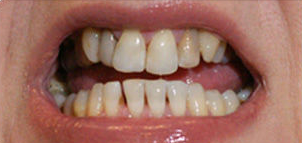 |
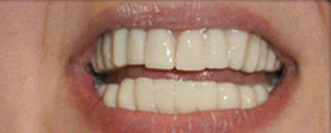 |